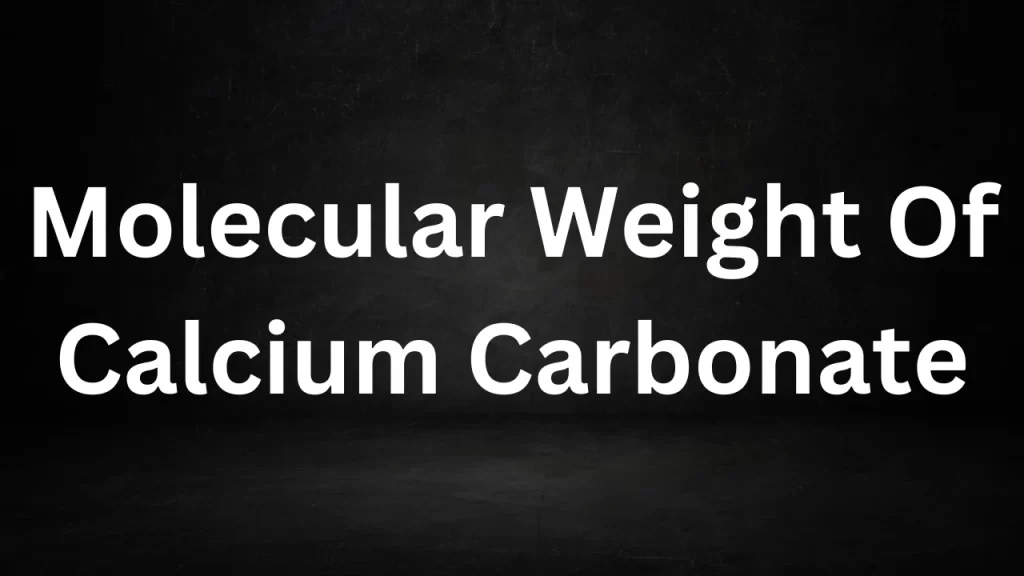Blog
Molecular Mass Of Acetic Acid
Molecular Mass Of Acetic Acid: In the realm of organic chemistry, understanding the molecular mass of compounds is a fundamental concept.
Molecular mass, also known as molecular weight or molar mass, plays a pivotal role in various chemical calculations and analyses. In this article, we will delve into the molecular mass of acetic acid (CH3COOH), a compound that is not only vital in the laboratory but also widely recognized in everyday life.

Molecular Mass Of Acetic Acid
Acetic Acid (CH3COOH): The Basics
Before we dive into the molecular mass of acetic acid, let’s get to know the compound itself. Acetic acid, chemically represented as CH3COOH, is a simple organic acid with a distinctive pungent odor and sour taste. It is the primary component responsible for the characteristic taste and smell of vinegar.
Acetic acid is both naturally occurring and synthetically produced. In the natural environment, acetic acid is produced via the fermentation of sugars and carbohydrates by specific bacterial strains. In controlled laboratory conditions, it can be synthetically created through diverse chemical processes.
Calculating the Molecular Mass
The molecular mass of a compound is the sum of the atomic masses of all the atoms present in a single molecule of that compound. To calculate the molecular mass of acetic acid (CH3COOH), we need to consider the atomic masses of its constituent elements: carbon (C), hydrogen (H), and oxygen (O).
Here are the approximate atomic masses of these elements:
- Carbon (C): Approximately 12.01 g/mol
- Hydrogen (H): Approximately 1.008 g/mol
- Oxygen (O): Approximately 16.00 g/mol
Now, let’s calculate the molecular mass of acetic acid:
Mole Mass (CH3COOH) = (Number of C atoms × Atomic Weight(C)) + (Number of H atoms × Atomic Weight(H)) + (Number of O atoms × Atomic Weight(O))
In the case of acetic acid, there are 2 carbon atoms (C), 4 hydrogen atoms (H), and 2 oxygen atoms (O) in a single molecule:
Mole Mass (CH3COOH) = (2 × 12.01 g/mol) + (4 × 1.008 g/mol) + (2 × 16.00 g/mol)
Mole Mass (CH3COOH) ≈ 60.05 g/mol
Therefore, the mole mass of acetic acid (CH3COOH) is approximately 60.05 grams per mole.
Significance of Molecular Mass
The mole mass of acetic acid, like that of any compound, is significant for several reasons:
- Stoichiometry: Mole mass is crucial in balancing chemical equations and determining the quantitative relationships between reactants and products in chemical reactions.
- Concentration Calculations: It aids in calculating the concentration of acetic acid in solutions, a vital aspect of analytical chemistry and laboratory work.
- Molar Mass: Molecular mass is used to calculate the molar mass of acetic acid, which is essential for determining the amount of acetic acid in moles.
- Physical Properties: Molecular mass influences the physical properties of acetic acid, including its density, melting point, and boiling point.
Practical Applications of Acetic Acid
Acetic acid is a versatile compound with numerous practical applications:
- Food Industry: It finds application as a food preservative and serves as the primary ingredient in vinegar, imparting the distinctive flavor and aroma associated with this condiment.
- Chemical Industry: Acetic acid serves as a precursor in the manufacturing of numerous chemicals, among them acetic anhydride, a critical component in the synthesis of aspirin and various other pharmaceutical compounds.
- Laboratory: It is employed as a reagent in chemical laboratories for various experiments and analyses.
- Textile Industry: In textile manufacturing, acetic acid is used in dyeing processes.
- Cleaning Products: It is found in household cleaning products like window cleaners.
In conclusion, the mole mass of acetic acid (CH3COOH) is approximately 60.05 grams per mole. This value serves as a crucial parameter in understanding the composition of acetic acid and its role in a wide range of applications, from culinary delights to industrial processes and scientific research. Acetic acid’s molecular mass is a cornerstone in the world of organic chemistry, and its versatility makes it an essential compound in various aspects of our lives.
Read More
- Molecular Weight Of Calcium Carbonate
- Molecular Weight Of Sodium Hydroxide
- Molecular Weight Of Aluminium
- Molecular Weight Of CaCl2
- Molecular Weight Of Copper
- Molecular Mass Of Ethanol
Frequently Asked Questions (FAQs) Molecular Mass Of Acetic Acid
1. What is the molecular mass of acetic acid (CH3COOH)?
The mole mass of acetic acid is approximately 60.05 grams per mole (g/mol).
2. Why is knowing the molecular mass of acetic acid important in chemistry?
The mole mass is essential in chemistry because it helps determine the compound’s mass and composition, enabling various calculations, including stoichiometry, concentration determination, and molar mass calculations.
3. What are the constituent elements of acetic acid, and what are their atomic weights?
Acetic acid (CH3COOH) contains three elements: carbon (C), hydrogen (H), and oxygen (O). Their approximate atomic weights are:
- Carbon (C): ~12.01 g/mol
- Hydrogen (H): ~1.008 g/mol
- Oxygen (O): ~16.00 g/mol
4. What is the method for determining the molecular mass of acetic acid?
The mole mass of acetic acid is calculated by summing the atomic masses of its constituent elements (C, H, and O) in one molecule. The calculation is as follows: Molecular Mass (CH3COOH) = (Number of C atoms × Atomic Weight(C)) + (Number of H atoms × Atomic Weight(H)) + (Number of O atoms × Atomic Weight(O))
5. What are some practical applications of acetic acid?
Acetic acid has a wide range of applications, including its use as a food preservative (vinegar), a precursor in pharmaceutical production, a reagent in chemical laboratories, a dyeing agent in the textile industry, and a component in cleaning products.
Molecular Weight Of Calcium Carbonate
Molecular Weight Of Calcium Carbonate: In the world of chemistry, the molecular weight of a compound is a fundamental concept that underpins various aspects of chemical analysis and research.
One compound that serves as an excellent illustration of this concept is calcium carbonate (CaCO3). In this article, we will explore the molecular weight of calcium carbonate and its significance in chemistry and everyday life.

Molecular Weight Of Calcium Carbonate
Calcium Carbonate (CaCO3): The Basics
Before delving into the molecular weight of calcium carbonate, let’s acquaint ourselves with this compound. Calcium carbonate, represented chemically as CaCO3, is a common chemical compound with widespread applications in various fields.
In its native state, calcium carbonate is present in geological formations and minerals like limestone, marble, and chalk. For centuries, these naturally formed deposits have been tapped into for a wide range of purposes, spanning from construction and artistic creations to medicinal applications. Calcium carbonate is also a major component of seashells and pearls.
Understanding Molecular Weight
The molecular weight of a compound is a numerical value that reflects the mass of one mole of that compound. It can be denoted in units such as atomic mass units (amu) or grams per mole (g/mol). To calculate the molecular weight of calcium carbonate, we need to consider the atomic weights of its constituent elements: calcium (Ca), carbon (C), and oxygen (O).
Here are the atomic weights of these elements:
- Calcium (Ca): Approximately 40.08 g/mol
- Carbon (C): Approximately 12.01 g/mol
- Oxygen (O): Approximately 16.00 g/mol
Now, we can calculate the molecular weight of calcium carbonate (CaCO3):
Molecular Weight (CaCO3) = Atomic Weight(Ca) + Atomic Weight(C) + 3 × Atomic Weight(O) Molecular Weight (CaCO3) = 40.08 g/mol + 12.01 g/mol + 3 × 16.00 g/mol Molecular Weight (CaCO3) ≈ 100.09 g/mol
Therefore, the mole weight of calcium carbonate is approximately 100.09 grams per mole.
Significance of Molecular Weight
Understanding the mole weight of a compound, such as calcium carbonate, has several practical implications:
- Stoichiometry: Mole weight plays a crucial role in balancing chemical equations and determining the proportions of substances involved in chemical reactions.
- Concentration Calculations: It is essential for calculating the concentration of calcium carbonate in solutions, which is significant in fields like environmental science and chemistry.
- Molar Mass: Mole weight is used to calculate the molar mass of calcium carbonate, which is useful for quantifying amounts in moles.
- Formulation: In various industries, including agriculture and pharmaceuticals, knowledge of molecular weight aids in formulating products and determining dosages.
- Physical Properties: Molecular weight influences the physical properties of a substance, such as its density and melting and boiling points.
Practical Applications of Calcium Carbonate
Calcium carbonate has a wide range of practical applications. It is used as a dietary supplement, in the paper industry as a filler and coating pigment, in the production of cement and concrete, and as an antacid for heartburn relief. Additionally, it serves as a key component in the manufacturing of ceramics, paints, plastics, and various building materials.
In conclusion, the mole weight of calcium carbonate (CaCO3) is approximately 100.09 grams per mole. This value is not only essential in understanding the composition of calcium carbonate but also pivotal in various scientific, industrial, and everyday applications. Whether you’re studying chemical reactions, determining concentrations, or manufacturing everyday products, the concept of molecular weight remains a cornerstone in the world of chemistry and materials science.
Read More
- Molecular Weight Of Sodium Hydroxide
- Molecular Weight Of Aluminium
- Molecular Weight Of CaCl2
- Molecular Weight Of Copper
- Molecular Mass Of Ethanol
Frequently Asked Questions (FAQs) Molecular Weight Of Calcium Carbonate
1. What is the molecular weight of calcium carbonate (CaCO3)?
The molecular weight of calcium carbonate (CaCO3) is approximately 100.09 grams per mole.
2. Why is the molecular weight of calcium carbonate important in chemistry?
The molecular weight is crucial in chemistry as it provides information about the compound’s mass and composition, which is essential for various calculations, including stoichiometry, concentration determination, and molar mass calculations.
3. What are the constituent elements of calcium carbonate, and what are their atomic weights?
Calcium carbonate consists of three elements: calcium (Ca), carbon (C), and oxygen (O). Here are their approximate atomic weights:
- Calcium (Ca): ~40.08 g/mol
- Carbon (C): ~12.01 g/mol
- Oxygen (O): ~16.00 g/mol
4. How is the molecular weight of calcium carbonate calculated?
The mole weight of calcium carbonate is calculated by summing the atomic weights of its constituent elements: Ca, C, and three O atoms. The calculation is as follows: Molecular Weight (CaCO3) = Atomic Weight(Ca) + Atomic Weight(C) + 3 × Atomic Weight(O)
5. What are some practical applications of calcium carbonate?
Calcium carbonate finds applications across a multitude of industries, encompassing agriculture (as a soil conditioner), pharmaceuticals (as a dietary supplement), construction (in the production of cement and concrete), paper manufacturing (as a filler), and serving as an antacid for relieving heartburn.
Molecular Weight Of Sodium Hydroxide
Molecular Weight Of Sodium Hydroxide: When it comes to understanding the properties and behavior of chemicals, one fundamental concept that chemists rely on is the molecular weight.
The molecular weight, often referred to as the molar mass or molecular mass, is a crucial parameter in chemistry that provides insights into the composition of a compound. In this article, we will explore the molecular weight of sodium hydroxide (NaOH), a common and important chemical compound.

Molecular Weight Of Sodium Hydroxide
Sodium Hydroxide (NaOH): The Basics
Before delving into the molecular weight of sodium hydroxide, let’s familiarize ourselves with this compound. Sodium hydroxide, with the chemical formula NaOH, is an inorganic compound that plays a significant role in various industries, including chemical manufacturing, water treatment, and the production of soaps and detergents. It is frequently referred to as caustic soda or lye.
Sodium hydroxide is a white, solid substance at room temperature and is highly soluble in water. It is known for its strong alkaline properties and is classified as a strong base. When dissolved in water, it dissociates into its constituent ions, sodium ions (Na⁺) and hydroxide ions (OH⁻). This dissociation is crucial to understanding its molecular weight.
Calculating the Molecular Weight
The molecular weight of a compound is ascertained by summing the atomic weights of all the constituent atoms within a single molecule of that compound. In the case of sodium hydroxide (NaOH), we have three elements: sodium (Na), oxygen (O), and hydrogen (H).
Let’s break down the atomic weights of these elements:
- Sodium (Na) has an atomic weight of approximately 22.99 grams per mole.
- Oxygen (O) has an atomic weight of approximately 15.999 grams per mole.
- Hydrogen (H) has an atomic weight of approximately 1.008 grams per mole.
To calculate the molecular weight of sodium hydroxide, we sum the atomic weights:
Molecular Weight (NaOH) = Atomic Weight(Na) + Atomic Weight(O) + Atomic Weight(H) Molecular Weight (NaOH) = 22.99 g/mol + 15.999 g/mol + 1.008 g/mol
Molecular Weight (NaOH) ≈ 39.997 g/mol
So, the molecular weight of sodium hydroxide (NaOH) is approximately 39.997 grams per mole.
Significance of Molecular Weight
Understanding the molecular weight of a compound is vital in various aspects of chemistry and science. Here are some key reasons why it’s important:
- Stoichiometry: Molecular weight is essential in balancing chemical equations and determining the quantitative relationships between reactants and products in chemical reactions.
- Concentration Calculations: It helps in calculating the concentration of a substance in a solution, which is crucial in analytical chemistry and laboratory work.
- It serves as a fundamental factor utilized in various chemical computations, encompassing stoichiometry, concentration determination, and molar mass calculations.
- Physical Properties: Molecular weight influences the physical properties of a compound, such as its melting point, boiling point, and density.
In conclusion, the mole weight of sodium hydroxide (NaOH) is approximately 39.997 grams per mole. This value is a fundamental piece of information that aids chemists and scientists in their work, from conducting chemical reactions to formulating solutions and understanding the behavior of this important compound in various applications. Sodium hydroxide’s molecular weight serves as a building block for deeper insights into its chemical properties and its role in diverse industrial processes.
Read More
- Molecular Weight Of Aluminium
- Molecular Weight Of CaCl2
- Molecular Weight Of Copper
- Molecular Mass Of Ethanol
- Molecular Mass of Ammonia
Frequently Asked Questions (FAQs) Molecular Weight Of Sodium Hydroxide
1. What is the molecular weight of sodium hydroxide (NaOH)?
The mole weight of sodium hydroxide (NaOH) is approximately 39.997 grams per mole.
2. Why is it important to know the molecular weight of sodium hydroxide?
Knowing the mole weight of sodium hydroxide is essential in chemistry as it helps chemists understand the composition of the compound. It serves as a fundamental factor utilized in various chemical computations, encompassing stoichiometry, concentration determination, and molar mass calculations.
3. What is sodium hydroxide (NaOH), and where is it commonly used?
Sodium hydroxide, chemically denoted as NaOH, is an inorganic substance widely acknowledged as caustic soda or lye. This highly alkaline compound sees extensive application in chemical manufacturing, water treatment, the manufacturing of soaps and detergents, and various industrial processes.
4. How is the molecular weight of sodium hydroxide calculated?
To determine the mole weight of sodium hydroxide (NaOH), one simply sums the atomic weights of its component elements: sodium (Na), oxygen (O), and hydrogen (H). For NaOH, the calculation is straightforward:
Molecular Weight (NaOH) = Atomic Weight(Na) + Atomic Weight(O) + Atomic Weight(H)
The Molecular Weight (NaOH) = 22.99 g/mol + 15.999 g/mol + 1.008 g/mol
Molecular Weight (NaOH) ≈ 39.997 g/mol
5. What are the practical applications of understanding the molecular weight of sodium hydroxide?
Understanding the mole weight of sodium hydroxide is crucial in a wide range of chemical and industrial processes. It finds application in establishing reaction stoichiometry, computing concentrations within solutions, determining molar masses, and making predictions regarding the physical characteristics of the compound.
Molecular Weight Of Aluminium
Molecular Weight Of Aluminium: Aluminium, symbolized as Al on the periodic table, is one of the most abundant elements on Earth. It is renowned for its versatile applications in various industries, including aerospace, construction, transportation, and packaging.
To comprehend its properties and behavior in chemical reactions, it is essential to delve into its molecular weight, a fundamental concept in chemistry.
In this article, we will explore what molecular weight is, how it relates to aluminium, and its significance in understanding the element’s various applications.

Molecular Weight Of Aluminium
Aluminium’s Atomic Structure
To understand the molecular weight of aluminium, let’s first examine its atomic structure. Aluminium is an element with the atomic number 13, which means it has 13 protons in its nucleus. It is commonly found in its stable form as an atom with 14 neutrons and 13 electrons. The atomic mass of aluminium, which is the sum of protons and neutrons in its nucleus, is approximately 26.98 amu (or u).
Calculating the Molecular Weight of Aluminium
Aluminium is not typically found as a diatomic molecule (like oxygen, O2, or hydrogen, H2), so its molecular weight is the same as its atomic mass. In other words, the mole weight of aluminium is approximately 26.98 amu.
Significance of Aluminium’s Mole Weight
Chemical Reactions: The mole weight of aluminium is essential in understanding its role in various chemical reactions. For instance, when aluminium reacts with oxygen (O2) to form aluminium oxide (Al2O3), the mole weight of aluminium plays a crucial role in stoichiometry, determining the exact quantities of reactants and products.
- Material Properties: Aluminium’s molecular weight also influences its physical and mechanical properties. Its relatively low molecular weight contributes to its lightweight nature, making it an ideal choice for applications requiring materials with a high strength-to-weight ratio, such as aircraft and automobile manufacturing.
- Alloy Formation: Aluminium is often alloyed with other elements to enhance its properties. The molecular weight of each alloying element is a key factor in determining the alloy’s overall properties, including strength, corrosion resistance, and melting point.
- Manufacturing and Fabrication: Understanding aluminium’s molecular weight is crucial in the manufacturing and fabrication processes. Engineers and metallurgists rely on this information when designing and producing aluminium-based products.
Conclusion
The mole weight of aluminium, approximately 26.98 amu, is a fundamental parameter in understanding the element’s behavior in various contexts, from chemical reactions to material properties and manufacturing processes. This knowledge is essential for scientists, engineers, and researchers working with aluminium, helping them harness its unique properties for a wide range of applications. Aluminium’s lightweight and versatile nature, driven in part by its molecular weight, continue to make it an indispensable element in modern industries.
Read More
- Molecular Weight Of CaCl2
- Molecular Weight Of Copper
- Molecular Mass Of Ethanol
- Molecular Mass of Ammonia
- Molecular Weight of H2O
Frequently Asked Questions (FAQs) Molecular Weight Of Aluminium
1. What is the molecular weight of aluminium?
The mole weight of aluminium is approximately 26.98 atomic mass units (amu) or unified atomic mass units (u).
2. How is the molecular weight of aluminium calculated?
To find aluminum’s molar mass, add up the atomic masses of all the atoms in a mole of aluminum. It is approximately equal to the atomic mass of aluminium, which is 26.98 amu.
3. Why is the molecular weight of aluminium important?
Aluminum’s molecular weight plays a pivotal role, influencing chemical reactions, material properties, alloy formulation, and aluminum-based manufacturing procedures significantly. It helps scientists and engineers understand and manipulate the behavior of aluminium in various applications.
4. What are some common applications of aluminium based on its molecular weight?
Aluminum’s light molecular weight makes it perfect for applications demanding high strength-to-weight ratios due to its inherent lightweight quality. This includes aerospace (aircraft and spacecraft), automotive manufacturing, construction, packaging, and consumer goods.
5. Can the molecular weight of aluminium change in different compounds or alloys?
The atomic mass of aluminum remains consistent, but the molar weight may fluctuate in various compounds or alloys due to additional elements. When aluminium forms compounds or alloys with other elements, the mole weight is influenced by the combined atomic masses of all the constituent atoms.
Molecular Weight Of CaCl2
Molecular Weight Of CaCl2: Calcium chloride, often encountered in various industrial, scientific, and everyday applications, is a compound of significant importance.
Comprehending the molecular weight of calcium chloride (CaCl2) serves as a foundational concept in chemistry and various disciplines. In this article, we will explore the concept of calculating the molecular weight of calcium chloride and its significance across different domains.

Molecular Weight Of CaCl2
The Composition of Calcium Chloride:
Calcium chloride, denoted as CaCl2, constitutes a chemical compound consisting of calcium (Ca) and chlorine (Cl) atoms. This hygroscopic salt finds diverse applications, from de-icing roads during winter to industrial processes and laboratory uses.
Calculating the Molecular Weight of Calcium Chloride:
The molecular weight of a substance, also referred to as molar mass, is the mass of one mole of that substance, typically expressed in grams per mole (g/mol). To determine the molecular weight of calcium chloride (CaCl2), we take into account the atomic masses of its constituent elements: calcium (Ca) and chlorine (Cl).
- The atomic mass of calcium (Ca) is approximately 40.08 g/mol.
- The atomic mass of chlorine (Cl) is approximately 35.45 g/mol.
To find the molecular weight of calcium chloride (CaCl2), we sum the atomic masses of one calcium atom and two chlorine atoms:
Molecular Weight of Calcium Chloride (CaCl2) (g/mol) = (1 × Atomic Mass of Calcium) + (2 × Atomic Mass of Chlorine)
Molecular Weight of Calcium Chloride ≈ (1 × 40.08 g/mol) + (2 × 35.45 g/mol) ≈ 110.98 g/mol
So, the molecular weight of calcium chloride (CaCl2) is approximately 110.98 g/mol.
Significance of Molecular Weight in Chemistry:
- Stoichiometry: Molecular weight plays a pivotal role in stoichiometry, aiding in determining the quantities of reactants and products in chemical reactions.
- Molarity: Within the realm of chemistry, molarity (M) serves as a concentration measure, expressed as moles per liter (mol/L). The calculation of molarity in solutions relies on the molecular weight of the solute.
- Chemical Equations: Molecular weight is essential for balancing chemical equations, ensuring the conservation of mass.
Practical Applications:
- De-Icing and Snow Removal: Calcium chloride finds extensive application in de-icing roads and sidewalks in winter because of its capability to reduce the freezing point of water.
- Dust Control: It is utilized to manage dust on unpaved roads and construction sites.
- Concrete Acceleration: Calcium chloride accelerates the setting of concrete, making it a valuable construction material.
Conclusion:
The molecular weight of calcium chloride (CaCl2), approximately 110.98 g/mol, is a fundamental concept in chemistry with extensive applications in various industries. It is a key factor in stoichiometry, molarity calculations, and chemical equation balancing. Calcium chloride’s versatile uses, influenced by its molecular weight, encompass de-icing, dust control, and concrete acceleration, highlighting the profound impact of chemistry on our daily lives and industrial processes.
Read More
- Molecular Weight Of Copper
- Molecular Mass Of Ethanol
- Molecular Mass of Ammonia
- Molecular Weight of H2O
- Molar Mass Of Sugar
Frequently Asked Questions (FAQs) Molecular Weight Of CaCl2
Q1: What is the molecular weight of calcium chloride (CaCl2)?
A1: The molecular weight of calcium chloride (CaCl2) is approximately 110.98 grams per mole (g/mol). This value is calculated based on the atomic masses of its constituent elements: calcium (Ca) and chlorine (Cl).
Q2: Why is the molecular weight of calcium chloride important in chemistry?
A2: Understanding the molecular weight of calcium chloride is crucial in chemistry because it is used in stoichiometry to determine reactant and product quantities, in molarity calculations for solutions containing calcium chloride, and in balancing chemical equations.
Q3: Can the molecular weight of calcium chloride change under different conditions?
A3: No, the molecular weight of calcium chloride remains constant regardless of temperature, pressure, or other conditions. It is a fixed value based on the atomic masses of calcium and chlorine.
Q4: What are the practical applications of calcium chloride related to its molecular weight?
A4: Calcium chloride has practical applications in de-icing roads, controlling dust on unpaved surfaces, accelerating concrete setting, and as a drying agent in various industries. Its molecular weight is relevant in determining the amount of calcium chloride used in these applications.
Q5: Is calcium chloride safe for use in food and pharmaceuticals?
A5: Calcium chloride is generally recognized as safe (GRAS) when used as a food additive and is used in food preservation, cheese making, and as a firming agent. In pharmaceuticals, it has specific uses and is regulated for safety.
Molecular Weight Of Copper
Molecular Weight Of Copper: Copper, with its distinctive reddish-brown color and remarkable conductivity, is a versatile metal that has been used by humans for thousands of years.
Comprehending the molecular weight of copper (Cu) stands as a cornerstone in the domains of chemistry and materials science. In this article, we will explore the concept of copper’s molecular weight, its calculation, and its significance across diverse fields.

Molecular Weight Of Copper
The Elemental Beauty of Copper:
Copper is one of the few elements that exist in nature in its pure metallic form. Its atomic symbol is Cu, and it belongs to the transition metals group on the periodic table. This metal exhibits excellent electrical conductivity, malleability, and corrosion resistance, making it invaluable for a wide range of applications.
Calculating the Molecular Weight of Copper:
The molecular weight of a substance, commonly known as molar mass, represents the mass of one mole of that substance, expressed in grams per mole (g/mol). When dealing with copper, which exists as individual atoms rather than molecules, calculating its molecular weight is a straightforward process.
The atomic mass of copper (Cu) is approximately 63.55 g/mol.
To find the mole weight of copper (Cu), we simply consider the atomic mass of a single copper atom:
Mole Weight of Copper (Cu) ≈ Atomic Mass of Copper (Cu) ≈ 63.55 g/mol
So, the mole weight of copper is approximately 63.55 g/mol.
Significance of Molecular Weight in Chemistry:
- Stoichiometry: Mole weight is vital in stoichiometry, where it helps determine the quantities of reactants and products in chemical reactions.
- Molarity: In chemistry, molarity (M) is a measure of concentration expressed as moles per liter (mol/L). Molecular weight is used to calculate molarity for solutions containing copper compounds.
- Chemical Reactions: Mole weight plays a pivotal role in balancing chemical equations, ensuring the conservation of mass.
Practical Applications:
- Electrical Wiring: Copper’s high electrical conductivity makes it the material of choice for electrical wiring in homes, buildings, and electronic devices.
- Piping and Tubing: In the realm of plumbing and HVAC systems, copper pipes and tubing find extensive application due to their exceptional resistance to corrosion and high thermal conductivity.
- Coinage: Many coins and medals are made of copper or copper alloys due to the metal’s durability and appealing appearance.
Conclusion:
The mole weight of copper (Cu), approximately 63.55 g/mol, is a foundational concept in chemistry that underpins various calculations and applications. It is especially significant in stoichiometry, molarity calculations, and the balancing of chemical equations. Copper’s remarkable properties, coupled with its molecular weight, have contributed to its enduring role in shaping our modern world, from powering our electronics to ensuring the flow of clean water in our homes. It stands as a testament to the profound impact of chemistry on our daily lives and industrial progress.
Read More
- Molecular Mass Of Ethanol
- Molecular Mass of Ammonia
- Molecular Weight of H2O
- Molar Mass Of Sugar
- Molecular Weight Of Air
Frequently Asked Questions (FAQs) Molecular Weight Of Copper
Q1: What is the molecular weight of copper (Cu)?
A1: The mole weight of copper (Cu) is approximately 63.55 grams per mole (g/mol). This value is based on the atomic mass of a single copper atom.
Q2: Why is knowing the molecular weight of copper important in chemistry?
A2: Understanding the mole weight of copper is essential in chemistry for stoichiometry, molarity calculations, and balancing chemical equations. It helps determine the quantities of copper in reactions and solutions.
Q3: Can the molecular weight of copper change under different conditions?
A3: No, the mole weight of copper remains constant regardless of temperature, pressure, or other conditions. It is a fixed value based on the atomic mass of copper.
Q4: What are the practical applications of copper related to its molecular weight?
A4: Copper’s practical applications are diverse, including electrical wiring, plumbing, coinage, and electronics. Its mole weight is relevant in determining the amount of copper used in various materials and processes.
Q5: Is the molecular weight of copper different when it forms compounds with other elements?
A5: The mole weight of copper may vary when it forms compounds with other elements, as the mole weight of a compound is determined by the combination of atoms within that compound. For example, copper sulfate (CuSO4) has a different mole weight due to the inclusion of sulfur and oxygen atoms.
Molecular Mass Of Ethanol
Molecular Mass Of Ethanol: Ethanol, known for its widespread use as an alcohol in beverages and as a fuel additive, holds a central position in the realms of chemistry and industry.
Understanding the mole mass of ethanol (C2H5OH) is fundamental in comprehending its properties and applications. In this article, we will explore the concept of the molecular mass of ethanol, its calculation, and its significance in various fields.
Molecular Mass Of Ethanol
The Chemical Composition of Ethanol:
Ethanol, commonly known as alcohol, is a chemical compound comprising carbon (C), hydrogen (H), and oxygen (O) atoms. Its mole formula is C2H5OH, which signifies that each ethanol molecule consists of two carbon atoms, six hydrogen atoms, and one oxygen atom.
Calculating the Molecular Mass of Ethanol:
The molecular mass of a substance is its mass when considering one mole of that substance, expressed in grams per mole (g/mol). To calculate the molecular mass of ethanol, we consider the atomic masses of its constituent elements, carbon (C), hydrogen (H), and oxygen (O).
- The atomic mass of carbon (C) is approximately 12.01 g/mol.
- The atomic mass of hydrogen (H) is approximately 1.01 g/mol.
- The atomic mass of oxygen (O) is approximately 16.00 g/mol.
To find the mole mass of ethanol (C2H5OH), we sum the atomic masses of its constituent atoms:
Mole Mass of Ethanol (C2H5OH) (g/mol) = (2 × Atomic Mass of Carbon) + (6 × Atomic Mass of Hydrogen) + (1 × Atomic Mass of Oxygen)
Mole Mass of Ethanol ≈ (2 × 12.01 g/mol) + (6 × 1.01 g/mol) + (1 × 16.00 g/mol) ≈ 46.07 g/mol
So, the mole mass of ethanol (C2H5OH) is approximately 46.07 g/mol.
Significance of Molecular Mass in Chemistry:
- Stoichiometry: Mole mass is crucial in stoichiometry, facilitating the determination of reactant and product quantities in chemical reactions.
- Molarity (M): in chemistry is a concentration measure expressed as moles per liter (mol/L). Molar mass is crucial in molarity calculations for solutions.
- Chemical Equations: Mole mass plays a pivotal role in balancing chemical equations, ensuring the conservation of mass.
Practical Applications:
- Beverage Industry: Ethanol is a key component in alcoholic beverages, and understanding its molecular mass is essential for quality control and labeling.
- Fuel Production: Ethanol is used as a biofuel additive, and its properties, influenced by molecular mass, affect combustion and engine performance.
- Pharmaceuticals: Ethanol is used in the pharmaceutical industry, where its molecular mass plays a role in drug formulations and dosage calculations.
Conclusion:
The mole mass of ethanol (C2H5OH), approximately 46.07 g/mol, is a fundamental concept in chemistry with extensive applications in numerous industries. It is a cornerstone in stoichiometry, molarity calculations, and chemical equation balancing. Whether in the production of alcoholic beverages, as a biofuel, or in pharmaceutical formulations, understanding the mole mass of ethanol is vital for precision and efficiency in various processes. It underscores the pivotal role of chemistry in both everyday life and industrial applications.
Read More
- Molecular Mass of Ammonia
- Molecular Weight of H2O
- Molar Mass Of Sugar
- Molecular Weight Of Air
- Molar Mass Of Ag
Frequently Asked Questions (FAQs) Molecular Mass Of Ethanol
Q1: What is the molecular mass of ethanol (C2H5OH)?
A1: The mole mass of ethanol, often represented as C2H5OH, is approximately 46.07 grams per mole (g/mol). To calculate this value, you add the atomic masses of its constituent elements: carbon (C), hydrogen (H), and oxygen (O).
Q2: Why is knowing the molecular mass of ethanol important in chemistry?
A2: Understanding the mole mass of ethanol is essential in chemistry because it aids in stoichiometry calculations, determining concentrations (molarity) in solutions, and balancing chemical equations.
Q3: What practical applications are related to ethanol’s molecular mass?
A3: Ethanol has various practical applications, including its use in alcoholic beverages, as a biofuel additive, and in pharmaceutical formulations. Its molecular mass influences its properties and applications in these industries.
Q4: Does the molecular mass of ethanol change with temperature or pressure?
A4: The mole mass of ethanol (C2H5OH) remains constant regardless of temperature or pressure. It is a fixed value based on the atomic masses of carbon, hydrogen, and oxygen.
Q5: Is ethanol the same as ethyl alcohol?
A5: Yes, ethanol is often referred to as ethyl alcohol. It is the same chemical compound and is used interchangeably in various contexts, including in beverages and industrial applications.
Molecular Mass of Ammonia
Molecular Mass of Ammonia: Ammonia, with its pungent odor and versatile applications, is a compound that holds significant importance in both chemistry and various industries.
Understanding the mole mass of ammonia (NH3) is fundamental in comprehending its properties and applications. In this article, we will delve into the concept of the molecular mass of ammonia, its calculation, and its relevance in different fields.

Molecular Mass of Ammonia
The Chemical Composition of Ammonia:
Ammonia, represented as NH3, is a compound composed of nitrogen (N) and hydrogen (H) atoms. It is a colorless gas at room temperature and has a characteristic, strong odor. The ammonia molecule consists of one nitrogen atom bonded to three hydrogen atoms.
Calculating the Molecular Mass of Ammonia:
The mole mass of a substance is defined as the mass of one mole of that substance, expressed in grams per mole (g/mol). To calculate the molecular mass of ammonia, we consider the atomic masses of its constituent elements, nitrogen (N) and hydrogen (H).
- The atomic mass of nitrogen (N) is approximately 14.01 g/mol.
- The atomic mass of hydrogen (H) is approximately 1.01 g/mol.
To find the mole mass of ammonia (NH3), we sum the atomic masses of one nitrogen atom and three hydrogen atoms:
Mole Mass of Ammonia (NH3) (g/mol) = (1 × Atomic Mass of Nitrogen) + (3 × Atomic Mass of Hydrogen)
Molecular Mass of Ammonia ≈ (1 × 14.01 g/mol) + (3 × 1.01 g/mol) ≈ 17.04 g/mol
So, the mole mass of ammonia (NH3) is approximately 17.04 g/mol.
Significance of Molecular Mass in Chemistry:
Stoichiometry: Mole mass plays a crucial role in stoichiometry, aiding in determining the quantities of reactants and products in chemical reactions.
- Molarity: In chemistry, molarity (M) is a measure of concentration expressed as moles per liter (mol/L). Mole mass is used to calculate molarity in solutions.
- Chemical Equations: Mole mass is vital for balancing chemical equations and ensuring the conservation of mass.
Practical Applications:
Fertilizer Production: Ammonia is a key component in fertilizer production, and understanding its mole mass is important for precise formulation.
- Cooling and Refrigeration: Ammonia is used as a refrigerant in various cooling systems, where its properties are influenced by its molecular mass.
- Household Cleaning: Ammonia-based cleaning products rely on the properties of ammonia, including its mole mass.
Conclusion:
The mole mass of ammonia (NH3), approximately 17.04 g/mol, is a fundamental concept in chemistry with wide-ranging applications in various industries. It plays a pivotal role in stoichiometry, molarity calculations, and balancing chemical equations. Whether in the laboratory, agriculture, or refrigeration, understanding the mole mass of ammonia is essential for precision and efficiency in a multitude of processes. It underscores the significance of chemistry in everyday life and industrial processes.
Read More
- Molecular Weight of H2O
- Molar Mass Of Sugar
- Molecular Weight Of Air
- Molar Mass Of Ag
- Molar Mass Of K
Frequently Asked Questions (FAQs) On Molecular Mass of Ammonia
Q1: What is the molecular mass of ammonia (NH3)?
A1: The mole mass of ammonia (NH3) is approximately 17.04 grams per mole (g/mol). To determine this value, you add the atomic masses of one nitrogen atom (N) and three hydrogen atoms (H) within a single ammonia molecule.
Q2: Why is knowing the molecular mass of ammonia important in chemistry?
A2: Understanding the mole mass of ammonia is crucial in chemistry because it enables precise calculations in stoichiometry, helps in determining concentrations (molarity) in solutions, and plays a fundamental role in balancing chemical equations.
Q3: What practical applications are there for ammonia that relate to its molecular mass?
A3: Ammonia has various practical applications, such as in fertilizer production, cooling and refrigeration systems, and household cleaning products. Its molecular mass influences its properties in these applications.
Q4: Does the molecular mass of ammonia change with temperature or pressure?
A4: The mole mass of ammonia (NH3) remains constant regardless of temperature or pressure. It is a fixed value based on the atomic masses of nitrogen and hydrogen.
Q5: Is ammonia a gas at room temperature?
A5: Yes, ammonia (NH3) is a colorless gas at room temperature, characterized by its pungent odor. It has a boiling point of -33.34 degrees Celsius (-28.012 degrees Fahrenheit) under standard atmospheric pressure.
Molecular Weight of H2O
Molecular Weight of H2O: Water, Earth’s most abundant and vital substance, consists of molecules possessing a distinct molecular weight critical for all life forms.
Understanding the molecular weight of water, represented as H2O, is fundamental not only in chemistry but also in various scientific and practical applications.
This article delves into the concept of H2O’s molecular weight, its calculation, and its importance across various fields of science and industry.

Molecular Weight of H2O
The Composition of Water:
Water, with the chemical formula H2O, consists of two hydrogen atoms (H) covalently bonded to a single oxygen atom (O). These atoms come together to form a water molecule. This molecular arrangement gives water its unique properties, such as its ability to dissolve a wide range of substances and its high heat capacity.
Calculating the Molecular Weight of H2O:
The molecular weight of a substance is defined as the mass of one mole of that substance, expressed in grams per mole (g/mol). To calculate the molecular weight of H2O, we consider the atomic masses of its constituent elements, hydrogen (H) and oxygen (O).
- The atomic mass of hydrogen (H) is approximately 1.01 g/mol.
- The atomic mass of oxygen (O) is approximately 16.00 g/mol.
To find the mole weight of H2O, we add the atomic masses of two hydrogen atoms and one oxygen atom:
Mole Weight of H2O (g/mol) = (2 × Atomic Mass of Hydrogen) + (1 × Atomic Mass of Oxygen)
Mole Weight of H2O ≈ (2 × 1.01 g/mol) + (1 × 16.00 g/mol) ≈ 18.02 g/mol
So, the mole weight of H2O (water) is approximately 18.02 g/mol.
Significance of Molecular Weight in Chemistry:
- Stoichiometry: Mole weight is crucial in stoichiometry, which involves determining the quantities of reactants and products in chemical reactions.
- Molarity: In chemistry, molarity (M) is a measure of the concentration of a substance in a solution. Molecular weight serves as a key factor in calculating molarity, a measure expressed as moles per liter (mol/L).
- Chemical Equations: Mole weight plays a vital role in balancing chemical equations to ensure the conservation of mass.
Real-World Applications:
- Laboratory Work: Chemists and researchers use the molecular weight of substances like water in laboratory experiments and analyses.
- Pharmaceuticals: Molecular weight is critical in pharmaceuticals for dosage calculations and drug formulation.
- Environmental Science: Understanding the molecular weight of water is essential in environmental science for assessing water quality and pollutant concentrations.
Conclusion:
The mole weight of H2O, approximately 18.02 g/mol, is a fundamental concept in chemistry and has broad applications in various scientific and practical fields. Whether in the laboratory, pharmaceutical industry, or environmental science, knowing the molecular weight of water is essential for precise measurements and calculations. It is a reminder of the simple yet profound principles that govern the behavior of substances at the molecular level, shaping our understanding of the world around us.
Read More
- Molecular Weight Of K2Cr2O7
- Molecular Weight Of Phosphorus
- Molecular Weight Of SO2
- Molecular Weight of Na2CO3
- Molecular Mass Of Sodium
Frequently Asked Questions (FAQs) on Molecular Weight of H2O
Q1: What is the molecular weight of H2O (water)?
A1: The mole weight of H2O, which is water, is approximately 18.02 grams per mole (g/mol). This value is calculated by summing the atomic masses of two hydrogen atoms (H) and one oxygen atom (O) in a water molecule.
Q2: Why is knowing the molecular weight of H2O important?
A2: Understanding the mole weight of H2O is crucial in various scientific and practical applications. It is used in chemistry for stoichiometry, molarity calculations, and balancing chemical equations. In fields like environmental science and pharmaceuticals, it helps in precise measurements and dosage calculations.
Q3: Does the molecular weight of H2O change with temperature or pressure?
A3: The molecular weight of H2O remains constant regardless of temperature or pressure. It is a fixed value based on the atomic masses of hydrogen and oxygen.
Q4: How is the molecular weight of H2O calculated?
A4: The mole weight of H2O is calculated by adding the atomic masses of its constituent elements. The atomic mass of hydrogen (H) is approximately 1.01 g/mol, and the atomic mass of oxygen (O) is approximately 16.00 g/mol. Therefore, for water (H2O), it is approximately 18.02 g/mol.
Q5: Can the molecular weight of H2O vary in different types of water?
A5: The mole weight of H2O is the same for all types of water, including distilled water, tap water, and seawater. It is a constant value based on the chemical composition of water, which consists of two hydrogen atoms and one oxygen atom per molecule.
Molar Mass Of Sugar
Molar Mass Of Sugar: Sugar, a ubiquitous and beloved substance in our daily lives, plays a significant role in both the culinary world and the field of chemistry.
While we often think of sugar solely in terms of its sweetening properties, it also holds importance in the realm of chemistry due to its molar mass. In this article, we will explore the concept of the molar mass of sugar, its chemical composition, and its practical applications.

Molar Mass Of Sugar
The Chemical Composition of Sugar:
Sugar, commonly referred to as sucrose, is a carbohydrate. Chemically, it is composed of carbon (C), hydrogen (H), and oxygen (O) atoms. The molecular formula of sucrose is C12H22O11. This formula tells us that each molecule of sucrose consists of 12 carbon atoms, 22 hydrogen atoms, and 11 oxygen atoms.
Determining the Molar Mass of Sugar:
The molar mass of a substance is its mass in grams per mole (g/mol), representing one mole of that substance. To calculate the mol mass of sugar (sucrose), we need to consider the atomic masses of its constituent elements. Here are the atomic masses of the elements in sucrose:
- – Carbon (C) has an atomic mass of approximately 12.01 g/mol.
- – Hydrogen (H) has an atomic mass of approximately 1.01 g/mol.
- – Oxygen (O) has an atomic mass of approximately 16.00 g/mol.
To find the mol mass of sugar, we sum the atomic masses of all the atoms in one mole of sucrose:
Mol Mass of Sugar (C12H22O11) = (12 × Atomic Mass of Carbon) + (22 × Atomic Mass of Hydrogen) + (11 × Atomic Mass of Oxygen)
Mol Mass of Sugar ≈ (12 × 12.01 g/mol) + (22 × 1.01 g/mol) + (11 × 16.00 g/mol) ≈ 342.34 g/mol
So, the mol mass of sugar (sucrose) is approximately 342.34 g/mol.
Significance of Molar Mass in Chemistry:
1. Stoichiometry: Molar mass is essential for stoichiometry, as it helps determine the quantity of reactants and products in chemical reactions.
2. Empirical and Molecular Formulas: Molar mass is used to find the empirical and molecular formulas of compounds, helping chemists understand their structures.
3. Concentration Calculations: In solutions, molar mass is vital for calculating concentrations, such as molarity (moles per liter), which is commonly used in chemistry labs.
4. Chemical Reactions: Molar mass plays a critical role in balancing chemical equations and ensuring the conservation of mass.
Conclusion:
The mol mass of sugar (sucrose), approximately 342.34 g/mol, is a fundamental concept in chemistry. Understanding the mol mass of compounds like sugar is crucial for various chemical calculations and has practical applications in fields ranging from cooking to pharmaceuticals. While sugar may continue to satisfy our sweet cravings, its chemical composition and molar mass continue to be of interest and significance in the world of science.
Read More
- Molecular Weight Of Air
- Molar Mass Of Ag
- Molar Mass Of K
- Molar Mass Of Magnesium
- Law Of Conservation Of Energy
Frequently Asked Questions (FAQs) Molar Mass Of Sugar
Q1: What is the molar mass of sugar?
A1: The mol mass of sugar, specifically sucrose (C12H22O11), is approximately 342.34 grams per mole (g/mol).
Q2: Why is the molar mass of sugar important in chemistry?
A2: The mol mass of sugar is crucial in chemistry because it allows us to determine the quantity of sugar in chemical reactions, calculate concentrations of sugar solutions, and find the empirical and molecular formulas of sugar compounds.
Q3: How is the molar mass of sugar calculated?
A3: To calculate the mol mass of sugar, you sum the atomic masses of all the atoms in one mole of sucrose (C12H22O11). This involves considering the atomic masses of carbon (C), hydrogen (H), and oxygen (O) in the compound.
Q4: Can the molar mass of sugar be used to measure the sweetness of sugar?
A4: No, the mol mass of sugar does not directly measure its sweetness. Sweetness is a sensory perception, while mol mass is a measure of the mass of sugar molecules per mole. The sweetness of sugar depends on various factors, including taste receptors in our mouths.
Q5: Is the molar mass of sugar the same for all types of sugar, like table sugar and brown sugar?
A5: The mol mass of sugar (sucrose) is the same regardless of the source. Whether it’s table sugar, brown sugar, or other sugar types, sucrose has the same chemical composition and molar mass. However, different sugars may contain impurities or water, which can affect their overall mass but not their molar mass.
